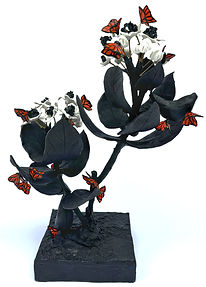DHATURA
My first stop was West Bengal, the land of my ancestors. It was here where I first saw these fine-looking plants. But it was during my trip to Nagaland when I truly fell in love with them. The Dhaturas here were twice as big and in shades I did not know they existed in! I was so mesmerized by the ‘Dance of the Dhaturas’, that I could not lift my eyes from them.
Interestingly, some call Dhatura the ‘Devil’s Trumpet’, while others call it the ‘Sacred Dhatura’. Although they have long been regarded as being extremely poisonous, they are also considered an aphrodisiac and have been used in Ayurveda as a medicine since ancient times. The flowers and the fruits have found an important place in rituals and prayers in the Hindu culture.
Standing proudly alongside roads, ditches, and sandy washes, Datura tells a story of survival, beauty, and mysticism.

DHATURA 1
Measurements (cm) : 32 X 32 X30 (approx)




DHATURA 2
Measurements (cm) : 40 X 35 X 30 (approx)




ABOUT THE PIECE
The Dhaturas have a very smart way of standing, with smooth stems and the fruit growing from where the stems meet.
Rough soil, supporting smooth stems that are in turn supporting the spiky fruits. This play of textures was very interesting to me and had to be addressed in my sculpture.
A special mention to the downward facing, ‘collar wearing’, spikey Dhatura fruit, something I had a lot of fun working on.




The Dhaturas have trumpet-shaped flowers that tends to grow very lush. Brass wires have been used to make the stamen of the flower.
Porcelain slip has been used to draw the details on the leaves.
Dhatura was the inspiration behind ‘Not for your Vase’. When I stood close to these majestic flowers, it felt like they were whispering to me and telling me to listen, very carefully, to the stories these flowers had to tell. It was here, standing with the Dhatura, when the lens through which I looked at these flowers changed completely.




